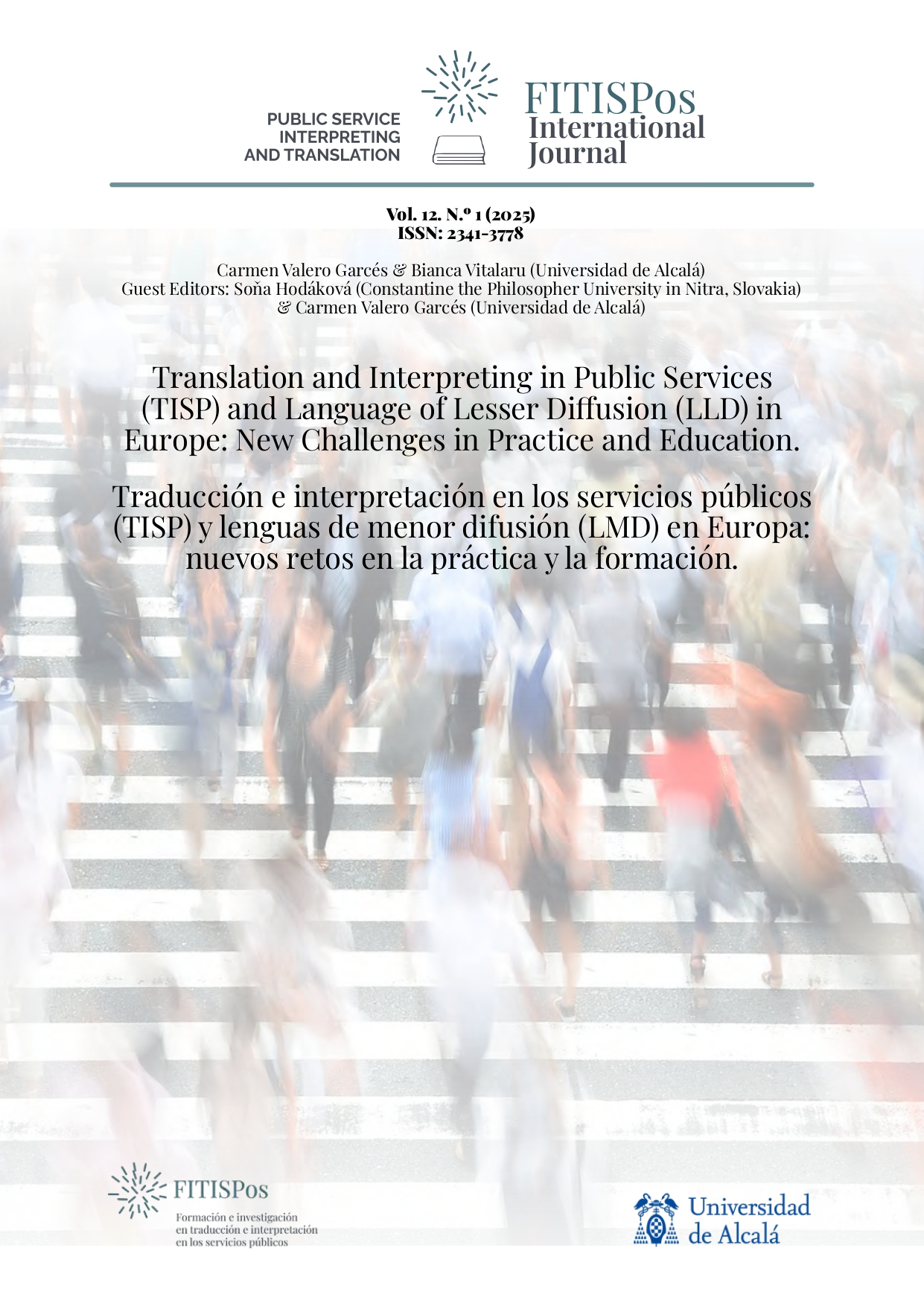Pedagogical challenges in teaching simultaneous interpreting and consecutive interpreting with notes to LLD students in heterogenous groups
DOI:
https://doi.org/10.37536/FITISPos-IJ.2025.12.1.420Keywords:
Languages of lesser diffusion, Consecutive interpreting, Teaching, Simultaneous interpretingAbstract
To guarantee access to professional interpreting services in the public sector (PSI), institutions and authorities must work together to detect, train, test, and monitor interpreter activity (Giambruno 2014, 96). With the world’s first Interpreting Act (2021) and a relatively long PSI training and monitoring tradition, Norway is a pioneer in this field. This article explores how simultaneous and consecutive interpreting technique is taught at Oslo Metropolitan University. The authors draw on their own teaching experience, ongoing dialogue with colleagues, comments from students and language mentors, and the experiential-dialogic approach to interpreter training (Felberg and Skaaden, 2020) to analyze the challenges of (1) adapting the conference interpreting-centered training tradition to the needs of PSI; (2) dealing with heterogeneous student groups in terms of professional experience and previous qualifications; and (3) teaching heterogeneous language groups with a high presence of languages of lesser diffusion, where students also happen to be market competitors.
Downloads
References
Act relating to public bodies’ responsibility for the use of interpreters, etc., Pub. L. No. LOV-2022-06-10-39 (2021). https://lovdata.no/dokument/NLE/lov/2021-06-11-79
Andres, D. (2015). Consecutive interpreting. In F. Pöchhacker (Ed.), Routledge encyclopedia of interpreting studies (pp. 159–161). Routledge.
Baeten, M., Kyndt, E., Struyven, K., & Dochy, F. (2010). Using student-centred learning environments to stimulate deep approaches to learning: Factors encouraging or discouraging their effectiveness. Educational research review, 5(3), 243–260. https://doi.org/10.1016/j.edurev.2010.06.001
Balogh, K., Salaets, H., & Van Schoor, D. (2016). TRaiLLD: Training in languages of lesser diffusion. Lannoo Campus.
Diriker, E. (2015). Conference interpreting. In H. Mikkelson & R. Jourdenais (Eds.), The Routledge handbook of interpreting (pp. 131–135). Routledge.
Felberg, T. R., & Skaaden, H. (2020). A blended approach to interpreter education: Online and onsite learning activities in concert. In N. K. Pokorn, M. Viezzi, & T. Radanović-Felberg (Eds.), Teacher education for community interpreting and intercultural mediation: Selected chapters (pp. 112–134). Ljubljana University Press.
Giambruno, C. (2014). Dealing with languages of lesser diffusion. In C. Giambruno (Ed.), Assessing legal interpreter quality through testing and certification: The Qualitas Project (pp. 93–107). Universidad de Alicante / Universitat d’Alacant.
Gillies, A. (2017). Note-taking for consecutive interpreting: A short course (2nd ed.). Routledge, Taylor & Francis Group.
Holub, E. (n.d.). Does intonation matter? The impact of monotony on listener comprehension. The Interpreters’ Newsletter, 15, 117–126.
Horváth, I. (2017). The speech behaviour of interpreters. Across languages and cultures, 18(2), 219–236. https://doi.org/10.1556/084.2017.18.2.3
IMDi. (2024). Tall og statistikk over innvandring og integrering. Integrerings- og mangfoldsdirektoratet. https://www.imdi.no/om-integrering-i-norge/statistikk/
Jones, R. (2002). Conference interpreting explained. https://doi.org/10.4324/9781315760322
Kalina, S. (2005). Quality assurance for interpreting processes. Meta, 50(2), 768–784. https://doi.org/10.7202/011017ar
Kolb, D. A. (1984). Experiential learning: Experiences as the source of learning and development. Prentice Hall.
Lov om offentlige organers ansvar for bruk av tolk mv. (tolkeloven) (2021). https://lovdata.no/dokument/NL/lov/2021-06-11-79
Monrad-Krohn, G. H. (1947). Dysprosody or altered “melody of language.” Brain, 70(4), 405–415. https://doi.org/10.1093/brain/70.4.405
Mørk, H. (2019). Tolking i justissektoren. Cappelen Damm Utdanning. https://utdanning.cappelendamm.no/_tolking-i-justissektoren-hanne-mork-9788202604127
Nilsen, A. B. (2022). Kommunikasjon i klasserommet. Cappelen Damm Akademisk.
Pöchhacker, F. (2022). Introducing interpreting studies (3rd ed.). Routledge.
Roberts, R. (1994). Community interpreting today and tomorrow. In P. W. Krawutschke (Ed.), Proceedings of the 35th Annual Conference of the American Translators Association (pp. 127–138). Learned Information.
Rudvin, M., & Tomassini, E. (2011). Interpreting in the community and workplace. Palgrave Macmillan UK. https://doi.org/10.1057/9780230307469
Russell, D. (2005). Consecutive and simultaneous interpreting. In T. Janzen (Ed.), Topics in signed language interpreting (pp. 135–164).
Setton, R. (2015). Fidelity. In F. Pöchhacker (Ed.), Routledge encyclopedia of interpreting studies (pp. 161–163). Routledge.
Skaaden, H. (2013). No set answers? Facilitating interpreter students’ learning in an experiential approach. In C. Wadensjö (Ed.), Training the trainers: Nordic seminar on interpreter education (pp. 11–26). Tolk- och översättarinstitutet.
Skaaden, H., & Felberg, T. R. (2020). Tandem teaching in the education of public service interpreters. In N. K. Pokorn, M. Viezzi, & T. Radanović Felberg (Eds.), Teacher education for community interpreting and intercultural mediation: Selected chapters (pp. 90–110). Ljubljana University Press.
Skaaden, H., & Wadensjö, C. (2014). Some considerations on the testing of interpreting skills. In C. Giambruno (Ed.), Assessing legal interpreter quality through testing and certification: The Qualitas Project (pp. 17–26). Universidad de Alicante / Universitat d’Alacant.
Statistics Norway. (2024). Immigrants and Norwegian-born to immigrant parents. https://www.ssb.no/en/befolkning/innvandrere/statistikk/innvandrere-og-norskfodte-med-innvandrerforeldre
Tiselius, E. (2015). Hva trenger tolkestudenten for å lære? English title: What do students of public service interpreting need to learn? FLEKS - Scandinavian Journal of Intercultural Theory and Practice, 2(1), Article 1. https://doi.org/10.7577/fleks.1296
Tiselius, E. (2021). Conference and community interpreting: Commonalities and differences. In The Routledge handbook of conference interpreting. Routledge.
Downloads
Published
Issue
Section
License
Copyright (c) 2025 Maria Abad Colom, Kristina Solum

This work is licensed under a Creative Commons Attribution-NonCommercial 4.0 International License.
Authors who publish with this journal agree to the following terms:
a. Authors retain copyright and guaranteeing the journal the right to be the first publication of the work as licensed under a Creative Commons Attribution License that allows others to share the work with an acknowledgment of the work's authorship and initial publication in this journal.
b. Authors can set separate additional agreements for non-exclusive distribution of the version of the work published in the journal (eg, place it in an institutional repository or publish it in a book), with an acknowledgment of its initial publication in this journal.
c. It allows and encourages authors to disseminate their work electronically (eg, in institutional repositories or on their own website) prior to and during the submission process, as it can lead to productive exchanges, as well as to a subpoena more early and most of the published works (See The Effect of Open Access) (in English).



